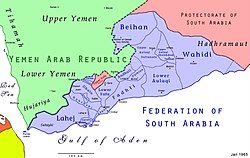Emirate of Beihan
| Emirate of Beihan إمارة بيحان |
|||||
| State of the Federation of South Arabia | |||||
|
|||||
|
Flag |
|||||
| Map of the Federation of South Arabia | |||||
| Capital | Suq Abdulla, (now Beihan) 13°25′N 45°40′E / 13.417°N 45.667°ECoordinates: 13°25′N 45°40′E / 13.417°N 45.667°E |
||||
| Government | Monarchy | ||||
| History | |||||
| • | Documented since | 1680 | |||
| • | Disestablished | 1967 | |||
Flag
Beihan or Bayhan (Arabic: بيحان Bayḥān), officially the Emirate of Beihan (Arabic: إمارة بيحان Imārat Bayḥān), was a state in the British Aden Protectorate and the Federation of South Arabia. Its capital was Suq Abdulla, now called Beihan. The Emirate was abolished in 1967 upon the founding of the People's Republic of South Yemen and is now part of the Republic of Yemen.
Beihan is a valley connected between al-Baidha in the north-west, Ma'rib in the east and Ataq in the south. It is a fertile valley irrigated by water streams fall from the northern mountains as well as from the dug wells. The main cultivated crops are dates, cereals and citrus and people depend on livestock to a large extent to survive. Nonetheless, people increasingly adopt trade and exchange commerce; in addition to incorporate to the government business.
Bayhan valley historically had several main groups. The Musabein Tribe living in the south which was dominated by Al-Saleh (Ahmed Saif tribe) and the Alfatima (Naji Alawi tribe). These two factions were engaged in constant feuds. Historically the middle of the valley was populated by the Al-Habieli family, descendants of the Prophet, who arrived in the valley in the late 1600s. They had been sent by the Imam of Yemen to protect the trade routes.
...
Wikipedia


